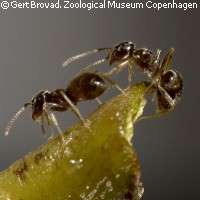Invasive ant syndrome: garden ant supercolonies thrive in Europe
A large-scale, interdisciplinary study by an international team of researchers has shown that the garden ant, Lasius neglectus, possessed invasive traits long before it started creating supercolonies in Europe, and that man-made transport networks gave them the push they needed to become successful invaders. The study was funded under the EU's Fifth Framework Programme (FP5) as part of the research training network INSECTS ('Integrated studies of the economy of insect societies') and by an individual Marie Curie Intra-European fellowship. The subsequent findings are published in the journal PLoS ONE. The researchers compared the invasive ant L. neglectus, which was first described in 1990 when it enveloped a neighbourhood in Budapest, Hungary, to its sister species L. turcicus, a non-invasive ant native to Turkey. They compared 'invasive' and 'pre-invasive' traits in the two ant species, and looked at their vulnerability to disease, gene flow, recognition of nest-fellows, and aggression towards ants from other nests. The invasive ants live in small networks of interconnected nests. They have several queens, mix freely between nests and mate underground. This relaxed intermingling is crucial to their success; their non-invasive relatives do not tolerate individuals from other nests and cluster around a single queen, which limits their expansion. According to the study, one reason that L. neglectus intermingles with ants from other nests is that they have a poor ability to recognise nest-mates. Lower degrees of antagonism, they write, make it easier to form supercolonies. The team observed that the non-invasive ant, L. turcicus, possesses many traits they consider to be 'pre-adaptations to invasiveness'; they believe that these traits evolved long before the ants left their original habitat. The invasive success of L. neglectus, the study found, is largely owing to these pre-adaptations, and to the fact that they shake off common parasites by staying on the move. 'Many invasive species appear to owe their ecological success at least partly to release from parasites, as not all natural enemies follow their host into a new range when founder populations are small,' according to the study. The researchers analysed two parasites that normally plague these ants, and found that when L. neglectus moves to a new site they are able to shake off these pathogens long enough to establish a new branch of the colony. The study concludes that the ants changed long before they moved out of Asia Minor and became invasive. 'This implies that the currently undiscovered native, non-invasive L. neglectus is expected to still occur somewhere in West Asia, unless it recently went extinct. If this scenario is correct, human transport and parasite release would then have been sufficient conditions for the emergence of the large-scale supercolonies that characterise the extant invasive populations.' The researchers caution that discovering this native, non-invasive L. neglectus ant is a matter of some urgency. 'Our results show that invasive L. neglectus populations are a potential problem of global dimensions, and a particular threat for man-made ecosystems in the cold-temperate climate zones that have so far suffered very little from invasive ants,' they conclude. Discovery of the missing ant, they hope, will provide the key to understanding and combating this damaging pest. Invasive pests are an increasing problem for the preservation of natural biodiversity. 'It is now becoming clear that rather many ant species share this lifestyle, so it is no surprise that a number of them have become invasive pests with giant supercolonies based on the same principles,' said Dr Sylvia Cremer of the University of Copenhagen in Denmark. Dr Jes Pedersen added, 'The future will see many more ants become invasive, so it is about time we understand their biology and this study is a major step in that direction.' Northern Europe has until recently been free from invasive pest ants, but the garden ant has been found in more than 100 locations across Europe, including Jena in Germany, Ghent in Belgium and Warsaw in Poland. It doesn't mind the cold, and sets up colonies that take over entire parks and gardens, exterminating native insects and spiders and damaging trees. It looks like a regular black garden ant but they are 10 to 100 times more of them in a given area.



